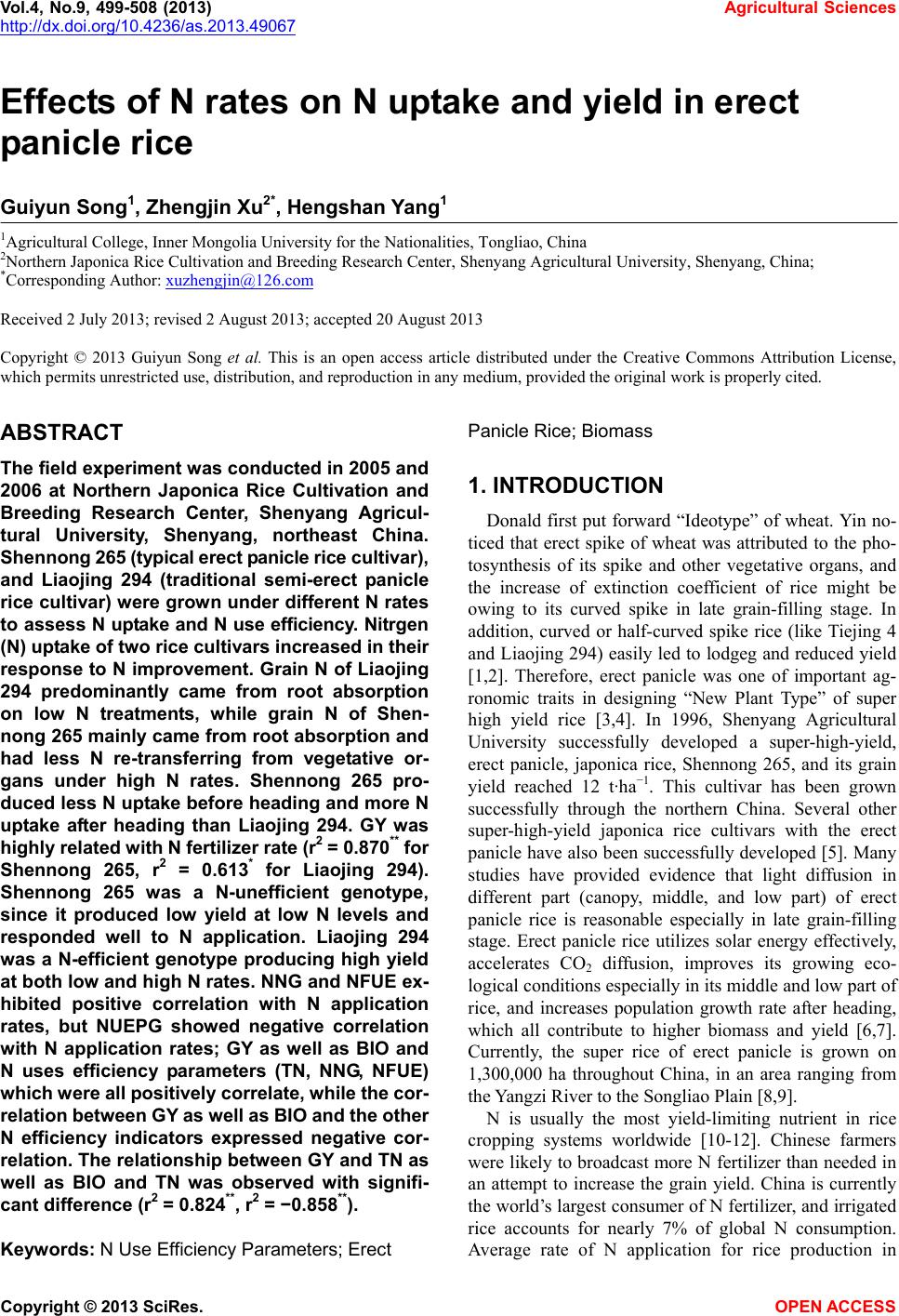 Vol.4, No.9, 499-508 (2013) Agricultural Sciences http://dx.doi.org/10.4236/as.2013.49067 Effects of N rates on N uptake and yield in erect panicle rice Guiyun Song1, Zhengjin Xu2*, Hengshan Yang1 1Agricultural College, Inner Mongolia University for the Nationalities, Tongliao, China 2Northern Japonica Rice Cultivation and Breeding Research Center, Shenyang Agricultural University, Shenyang, China; *Corresponding Author: xuzhengjin@126.com Received 2 July 2013; revised 2 August 2013; accepted 20 August 2013 Copyright © 2013 Guiyun Song et al. This is an open access article distributed under the Creative Commons Attribution License, which permits unrestricted use, distribution, and reproduction in any medium, provided the original work is properly cited. ABSTRACT The field experiment was conducted in 2005 and 2006 at Northern Japonica Rice Cultivation and Breeding Research Center, Shenyang Agricul- tural University, Shenyang, northeast China. Shennong 265 (typical erect panicle rice cultivar), and Liaojing 294 (traditional semi-erect panicle rice cultivar) were grown under different N rates to assess N uptake and N use efficiency. Nitrgen (N) uptake of two rice cultivars increased in their response to N improvement. Grain N of Liaojing 294 predominantly came from root absorption on low N treatments, while grain N of Shen- nong 265 mainly came from root absorption and had less N re-transferring from vegetative or- gans under high N rates. Shennong 265 pro- duced less N uptake before heading and more N uptake after heading than Liaojing 294. GY was highly related with N fertilizer rate (r2 = 0.870** for Shennong 265, r2 = 0.613* for Liaojing 294). Shennong 265 was a N-unefficient genotype, since it produced low yield at low N levels and responded well to N application. Liaojing 294 was a N-efficient genotype producing high yield at both low and high N rates. NNG and NFUE ex- hibited positive correlation with N application rates, but NUEPG showed negative correlation with N application rates; GY as well as BIO and N uses efficiency parameters (TN, NNG, NFUE) which were all positively correlate, while the cor- relation between GY as well as BIO and the other N efficiency indicators expressed negative cor- relation. The relationship between GY and TN as well as BIO and TN was observed with signifi- cant difference (r2 = 0.824**, r2 = −0.858**). Keywords: N Use Efficiency Parameters; Erect Panicle Rice; Biomass 1. INTRODUCTION Donald first put forward “Ideotype” of wheat. Yin no- ticed that erect spike of wheat was attributed to the pho- tosynthesis of its spike and other vegetative organs, and the increase of extinction coefficient of rice might be owing to its curved spike in late grain-filling stage. In addition, curved or half-curved spike rice (like Tiejing 4 and Liaojing 294) easily led to lodgeg and reduced yield [1,2]. Therefore, erect panicle was one of important ag- ronomic traits in designing “New Plant Type” of super high yield rice [3,4]. In 1996, Shenyang Agricultural University successfully developed a super-high-yield, erect panicle, japonica rice, Shennong 265, and its grain yield reached 12 t·ha−1. This cultivar has been grown successfully through the northern China. Several other super-high-yield japonica rice cultivars with the erect panicle have also been successfully developed [5]. Many studies have provided evidence that light diffusion in different part (canopy, middle, and low part) of erect panicle rice is reasonable especially in late grain-filling stage. Erect panicle rice utilizes solar energy effectively, accelerates CO2 diffusion, improves its growing eco- logical conditions especially in its middle and low part of rice, and increases population growth rate after heading, which all contribute to higher biomass and yield [6,7]. Currently, the super rice of erect panicle is grown on 1,300,000 ha throughout China, in an area ranging from the Yangzi River to the Songliao Plain [8,9]. N is usually the most yield-limiting nutrient in rice cropping systems worldwide [10-12]. Chinese farmers were likely to broadcast more N fertilizer than needed in an attempt to increase the grain yield. China is currently the world’s largest consumer of N fertilizer, and irrigated rice accounts for nearly 7% of global N consumption. Average rate of N application for rice production in Copyright © 2013 SciRes. OPEN ACCESS 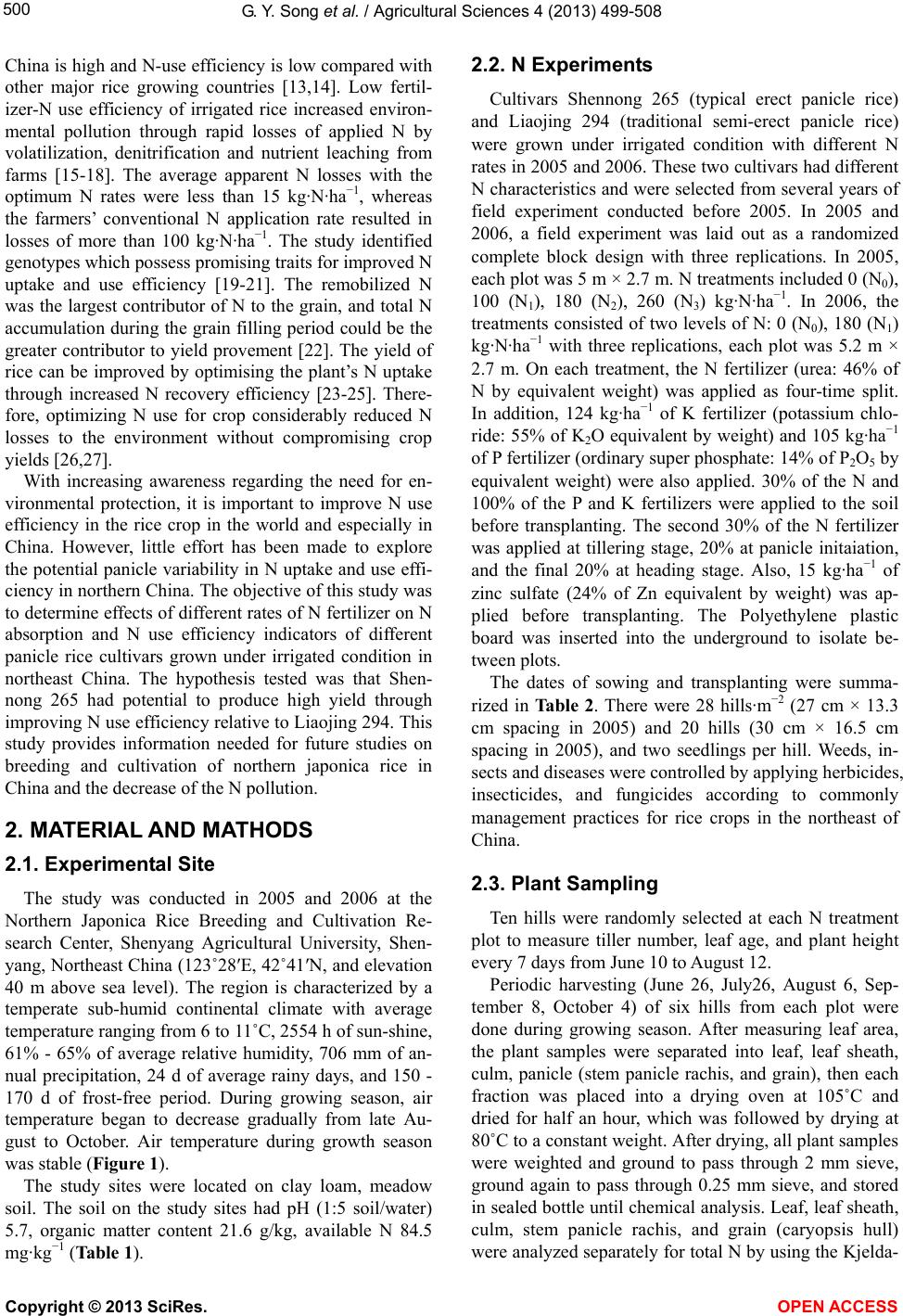 G. Y. Song et al. / Agricultural Sciences 4 (2013) 499-508 500 China is high and N-use efficiency is low compared with other major rice growing countries [13,14]. Low fertil- izer-N use efficiency of irrigated rice increased environ- mental pollution through rapid losses of applied N by volatilization, denitrification and nutrient leaching from farms [15-18]. The average apparent N losses with the optimum N rates were less than 15 kg·N·ha−1, whereas the farmers’ conventional N application rate resulted in losses of more than 100 kg·N·ha−1. The study identified genotypes which possess promising traits for improved N uptake and use efficiency [19-21]. The remobilized N was the largest contributor of N to the grain, and total N accumulation during the grain filling period could be the greater contributor to yield provement [22]. The yield of rice can be improved by optimising the plant’s N uptake through increased N recovery efficiency [23-25]. There- fore, optimizing N use for crop considerably reduced N losses to the environment without compromising crop yields [26,27]. With increasing awareness regarding the need for en- vironmental protection, it is important to improve N use efficiency in the rice crop in the world and especially in China. However, little effort has been made to explore the potential panicle variability in N uptake and use effi- ciency in northern China. The objective of this study was to determine effects of different rates of N fertilizer on N absorption and N use efficiency indicators of different panicle rice cultivars grown under irrigated condition in northeast China. The hypothesis tested was that Shen- nong 265 had potential to produce high yield through improving N use efficiency relative to Liaojing 294. This study provides information needed for future studies on breeding and cultivation of northern japonica rice in China and the decrease of the N pollution. 2. MATERIAL AND MATHODS 2.1. Experimental Site The study was conducted in 2005 and 2006 at the Northern Japonica Rice Breeding and Cultivation Re- search Center, Shenyang Agricultural University, Shen- yang, Northeast China (123˚28′E, 42˚41′N, and elevation 40 m above sea level). The region is characterized by a temperate sub-humid continental climate with average temperature ranging from 6 to 11˚C, 2554 h of sun-shine, 61% - 65% of average relative humidity, 706 mm of an- nual precipitation, 24 d of average rainy days, and 150 - 170 d of frost-free period. During growing season, air temperature began to decrease gradually from late Au- gust to October. Air temperature during growth season was stable (Figure 1). The study sites were located on clay loam, meadow soil. The soil on the study sites had pH (1:5 soil/water) 5.7, organic matter content 21.6 g/kg, available N 84.5 mg· k g −1 (Table 1). 2.2. N Experiments Cultivars Shennong 265 (typical erect panicle rice) and Liaojing 294 (traditional semi-erect panicle rice) were grown under irrigated condition with different N rates in 2005 and 2006. These two cultivars had different N characteristics and were selected from several years of field experiment conducted before 2005. In 2005 and 2006, a field experiment was laid out as a randomized complete block design with three replications. In 2005, each plot was 5 m × 2.7 m. N treatments included 0 (N0), 100 (N1), 180 (N2), 260 (N3) kg·N·ha−1. In 2006, the treatments consisted of two levels of N: 0 (N0), 180 (N1) kg·N·ha−1 with three replications, each plot was 5.2 m × 2.7 m. On each treatment, the N fertilizer (urea: 46% of N by equivalent weight) was applied as four-time split. In addition, 124 kg·ha−1 of K fertilizer (potassium chlo- ride: 55% of K2O equivalent by weight) and 105 kg·ha−1 of P fertilizer (ordinary super phosphate: 14% of P2O5 by equivalent weight) were also applied. 30% of the N and 100% of the P and K fertilizers were applied to the soil before transplanting. The second 30% of the N fertilizer was applied at tillering stage, 20% at panicle initaiation, and the final 20% at heading stage. Also, 15 kg·ha−1 of zinc sulfate (24% of Zn equivalent by weight) was ap- plied before transplanting. The Polyethylene plastic board was inserted into the underground to isolate be- tween plots. The dates of sowing and transplanting were summa- rized in Tab le 2. There were 28 hills·m−2 (27 cm × 13.3 cm spacing in 2005) and 20 hills (30 cm × 16.5 cm spacing in 2005), and two seedlings per hill. Weeds, in- sects and diseases were controlled by applying herbicides, insecticides, and fungicides according to commonly management practices for rice crops in the northeast of China. 2.3. Plant Sampling Ten hills were randomly selected at each N treatment plot to measure tiller number, leaf age, and plant height every 7 days from June 10 to August 12. Periodic harvesting (June 26, July26, August 6, Sep- tember 8, October 4) of six hills from each plot were done during growing season. After measuring leaf area, the plant samples were separated into leaf, leaf sheath, culm, panicle (stem panicle rachis, and grain), then each fraction was placed into a drying oven at 105˚C and dried for half an hour, which was followed by drying at 80˚C to a constant weight. After drying, all plant samples were weighted and ground to pass through 2 mm sieve, ground again to pass through 0.25 mm sieve, and stored in sealed bottle until chemical analysis. Leaf, leaf sheath, culm, stem panicle rachis, and grain (caryopsis hull) were analyzed separately for total N by using the Kjelda- Copyright © 2013 SciRes. OPEN ACCESS 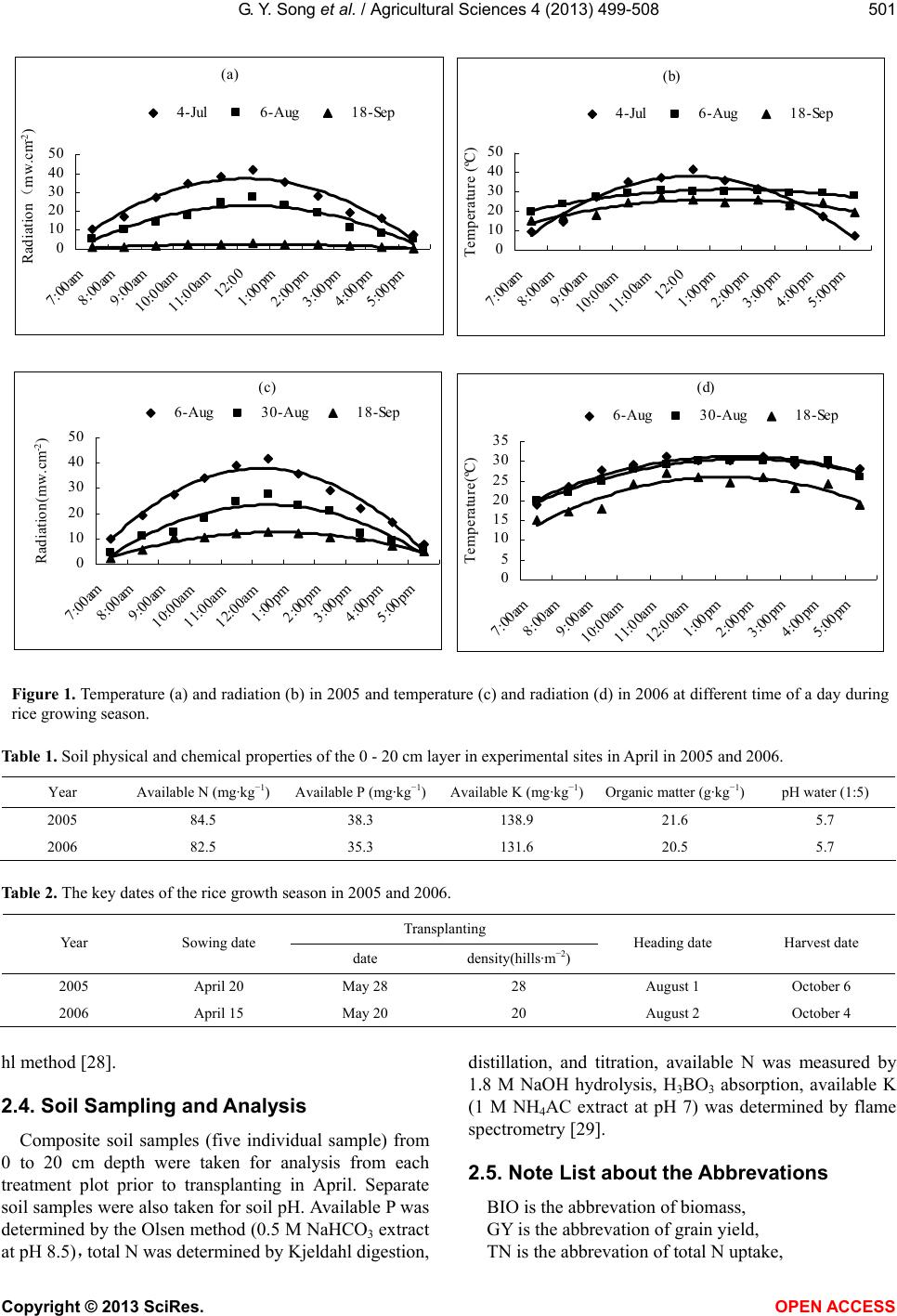 G. Y. Song et al. / Agricultural Sciences 4 (2013) 499-508 Copyright © 2013 SciRes. 501 (a) 0 10 20 30 40 50 7:00am 8:00am 9:00am 10:00am 11:00am 12:00 1:00pm 2:00pm 3: 00pm 4:00pm 5: 00pm Radiation(mw.cm -2 ) 4-Jul6-Aug 18-Sep (b) 0 10 20 30 40 50 7:00am 8:00am 9:00am 10: 00am 11:00am 12: 00 1:00pm 2: 00pm 3:00pm 4:00pm 5: 00pm Temperature (ºC) 4-Jul 6-Aug18-Sep (c) 0 10 20 30 40 50 7:00am 8:00am 9:00am 10:00am 11:00a m 12:00am 1: 00pm 2: 00pm 3:00pm 4:00pm 5:00pm Radiation(mw.cm -2 ) 6-Aug 30-Aug 18-Sep (d) 0 5 10 15 20 25 30 35 7:00am 8:00am 9:00am 10: 00am 11:0 0am 12:0 0am 1:00pm 2:00pm 3:00pm 4:00pm 5:00pm Tem per atu re( ºC) 6-Aug 30-Aug 18-Sep Figure 1. Temperature (a) and radiation (b) in 2005 and temperature (c) and radiation (d) in 2006 at different time of a day during rice growing season. Table 1. Soil physical and chemical properties of the 0 - 20 cm layer in experimental sites in April in 2005 and 2006. Year Available N (mg·kg−1) Available P (mg·kg−1)Available K (mg·kg−1)Organic matter (g·kg−1) pH water (1:5) 2005 84.5 38.3 138.9 21.6 5.7 2006 82.5 35.3 131.6 20.5 5.7 Table 2. The key dates of the rice growth season in 2005 and 2006. Transplanting Year Sowing date date density(hills·m−2) Heading date Harvest date 2005 April 20 May 28 28 August 1 October 6 2006 April 15 May 20 20 August 2 October 4 hl method [28]. 2.4. Soil Sampling and Analysis Composite soil samples (five individual sample) from 0 to 20 cm depth were taken for analysis from each treatment plot prior to transplanting in April. Separate soil samples were also taken for soil pH. Available P was determined by the Olsen method (0.5 M NaHCO3 extract at pH 8.5),total N was determined by Kjeldahl digestion, distillation, and titration, available N was measured by 1.8 M NaOH hydrolysis, H3BO3 absorption, available K (1 M NH4AC extract at pH 7) was determined by flame spectrometry [29]. 2.5. Note List about the Abbrevations BIO is the abbrevation of biomass, GY is the abbrevation of grain yield, TN is the abbrevation of total N uptake, OPEN ACCESS 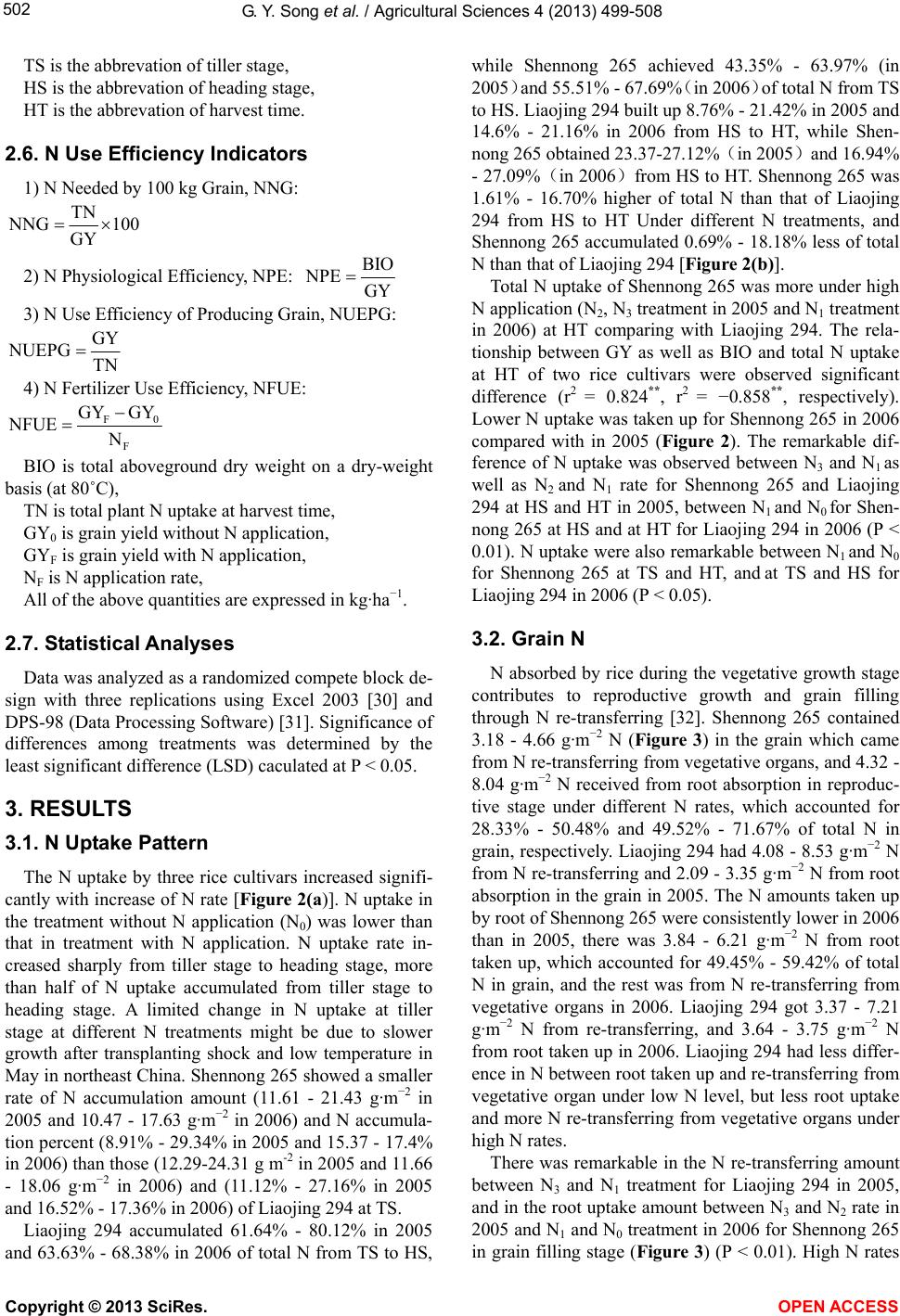 G. Y. Song et al. / Agricultural Sciences 4 (2013) 499-508 502 TS is the abbrevation of tiller stage, HS is the abbrevation of heading stage, HT is the abbrevation of harvest time. 2.6. N Use Efficiency Indicators 1) N Needed by 100 kg Grain, NNG: TN NG 100 GY 2) N Physiological Efficiency, NPE: BIO NPE GY 3) N Use Efficiency of Producing Grain, NUEPG: GY NUEPG TN 4) N Fertilizer Use Efficiency, NFUE: F0 F GY GY NFUE N BIO is total aboveground dry weight on a dry-weight basis (at 80˚C), TN is total plant N uptake at harvest time, GY0 is grain yield without N application, GYF is grain yield with N application, NF is N application rate, All of the above quantities are expressed in kg·ha−1. 2.7. Statistical Analyses Data was analyzed as a randomized compete block de- sign with three replications using Excel 2003 [30] and DPS-98 (Data Processing Software) [31]. Significance of differences among treatments was determined by the least significant difference (LSD) caculated at P < 0.05. 3. RESULTS 3.1. N Uptake Pattern The N uptake by three rice cultivars increased signifi- cantly with increase of N rate [Figure 2(a)]. N uptake in the treatment without N application (N0) was lower than that in treatment with N application. N uptake rate in- creased sharply from tiller stage to heading stage, more than half of N uptake accumulated from tiller stage to heading stage. A limited change in N uptake at tiller stage at different N treatments might be due to slower growth after transplanting shock and low temperature in May in northeast China. Shennong 265 showed a smaller rate of N accumulation amount (11.61 - 21.43 g·m−2 in 2005 and 10.47 - 17.63 g·m−2 in 2006) and N accumula- tion percent (8.91% - 29.34% in 2005 and 15.37 - 17.4% in 2006) than those (12.29-24.31 g m-2 in 2005 and 11.66 - 18.06 g·m−2 in 2006) and (11.12% - 27.16% in 2005 and 16.52% - 17.36% in 2006) of Liaojing 294 at TS. Liaojing 294 accumulated 61.64% - 80.12% in 2005 and 63.63% - 68.38% in 2006 of total N from TS to HS, while Shennong 265 achieved 43.35% - 63.97% (in 2005)and 55.51% - 67.69%(in 2006)of total N from TS to HS. Liaojing 294 built up 8.76% - 21.42% in 2005 and 14.6% - 21.16% in 2006 from HS to HT, while Shen- nong 265 obtained 23.37-27.12%(in 2005)and 16.94% - 27.09%(in 2006)from HS to HT. Shennong 265 was 1.61% - 16.70% higher of total N than that of Liaojing 294 from HS to HT Under different N treatments, and Shennong 265 accumulated 0.69% - 18.18% less of total N than that of Liaojing 294 [Figure 2(b)]. Total N uptake of Shennong 265 was more under high N application (N2, N3 treatment in 2005 and N1 treatment in 2006) at HT comparing with Liaojing 294. The rela- tionship between GY as well as BIO and total N uptake at HT of two rice cultivars were observed significant difference (r2 = 0.824**, r2 = −0.858**, respectively). Lower N uptake was taken up for Shennong 265 in 2006 compared with in 2005 (Figure 2). The remarkable dif- ference of N uptake was observed between N3 and N1 as well as N2 and N1 rate for Shennong 265 and Liaojing 294 at HS and HT in 2005, between N1 and N0 for Shen- nong 265 at HS and at HT for Liaojing 294 in 2006 (P < 0.01). N uptake were also remarkable between N1 and N0 for Shennong 265 at TS and HT, and at TS and HS for Liaojing 294 in 2006 (P < 0.05). 3.2. Grain N N absorbed by rice during the vegetative growth stage contributes to reproductive growth and grain filling through N re-transferring [32]. Shennong 265 contained 3.18 - 4.66 g·m−2 N (Figure 3) in the grain which came from N re-transferring from vegetative organs, and 4.32 - 8.04 g·m−2 N received from root absorption in reproduc- tive stage under different N rates, which accounted for 28.33% - 50.48% and 49.52% - 71.67% of total N in grain, respectively. Liaojing 294 had 4.08 - 8.53 g·m−2 N from N re-transferring and 2.09 - 3.35 g·m−2 N from root absorption in the grain in 2005. The N amounts taken up by root of Shennong 265 were consistently lower in 2006 than in 2005, there was 3.84 - 6.21 g·m−2 N from root taken up, which accounted for 49.45% - 59.42% of total N in grain, and the rest was from N re-transferring from vegetative organs in 2006. Liaojing 294 got 3.37 - 7.21 g·m−2 N from re-transferring, and 3.64 - 3.75 g·m−2 N from root taken up in 2006. Liaojing 294 had less differ- ence in N between root taken up and re-transferring from vegetative organ under low N level, but less root uptake and more N re-transferring from vegetative organs under high N rates. There was remarkable in the N re-transferring amount between N3 and N1 treatment for Liaojing 294 in 2005, and in the root uptake amount between N3 and N2 rate in 2005 and N1 and N0 treatment in 2006 for Shennong 265 in grain filling stage (Figure 3) (P < 0.01). High N rates Copyright © 2013 SciRes. OPEN ACCESS 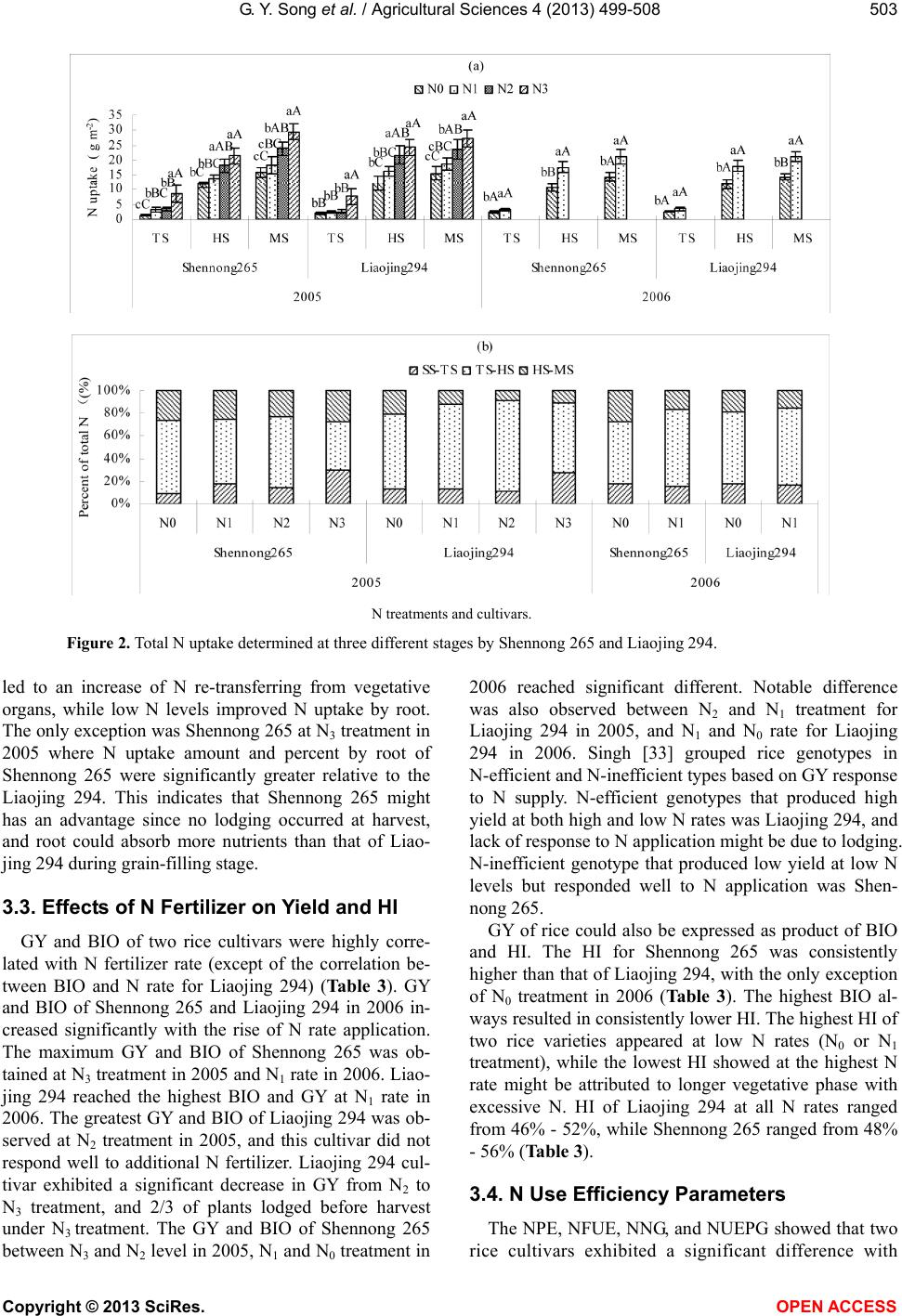 G. Y. Song et al. / Agricultural Sciences 4 (2013) 499-508 Copyright © 2013 SciRes. 503 N treatments and cultivars. Figure 2. Total N uptake determined at three different stages by Shennong 265 and Liaojing 294. led to an increase of N re-transferring from vegetative organs, while low N levels improved N uptake by root. The only exception was Shennong 265 at N3 treatment in 2005 where N uptake amount and percent by root of Shennong 265 were significantly greater relative to the Liaojing 294. This indicates that Shennong 265 might has an advantage since no lodging occurred at harvest, and root could absorb more nutrients than that of Liao- jing 294 during grain-filling stage. 3.3. Effects of N Fertilizer on Yield and HI GY and BIO of two rice cultivars were highly corre- lated with N fertilizer rate (except of the correlation be- tween BIO and N rate for Liaojing 294) (Tab le 3). GY and BIO of Shennong 265 and Liaojing 294 in 2006 in- creased significantly with the rise of N rate application. The maximum GY and BIO of Shennong 265 was ob- tained at N3 treatment in 2005 and N1 rate in 2006. Liao- jing 294 reached the highest BIO and GY at N1 rate in 2006. The greatest GY and BIO of Liaojing 294 was ob- served at N2 treatment in 2005, and this cultivar did not respond well to additional N fertilizer. Liaojing 294 cul- tivar exhibited a significant decrease in GY from N2 to N3 treatment, and 2/3 of plants lodged before harvest under N3 treatment. The GY and BIO of Shennong 265 between N3 and N2 level in 2005, N1 and N0 treatment in 2006 reached significant different. Notable difference was also observed between N2 and N1 treatment for Liaojing 294 in 2005, and N1 and N0 rate for Liaojing 294 in 2006. Singh [33] grouped rice genotypes in N-efficient and N-inefficient types based on GY response to N supply. N-efficient genotypes that produced high yield at both high and low N rates was Liaojing 294, and lack of response to N application might be due to lodging. N-inefficient genotype that produced low yield at low N levels but responded well to N application was Shen- nong 265. GY of rice could also be expressed as product of BIO and HI. The HI for Shennong 265 was consistently higher than that of Liaojing 294, with the only exception of N0 treatment in 2006 (Ta bl e 3). The highest BIO al- ways resulted in consistently lower HI. The highest HI of two rice varieties appeared at low N rates (N0 or N1 treatment), while the lowest HI showed at the highest N rate might be attributed to longer vegetative phase with excessive N. HI of Liaojing 294 at all N rates ranged from 46% - 52%, while Shennong 265 ranged from 48% - 56% (Table 3). 3.4. N Use Efficiency Parameters The NPE, NFUE, NNG, and NUEPG showed that two rice cultivars exhibited a significant difference with OPEN ACCESS 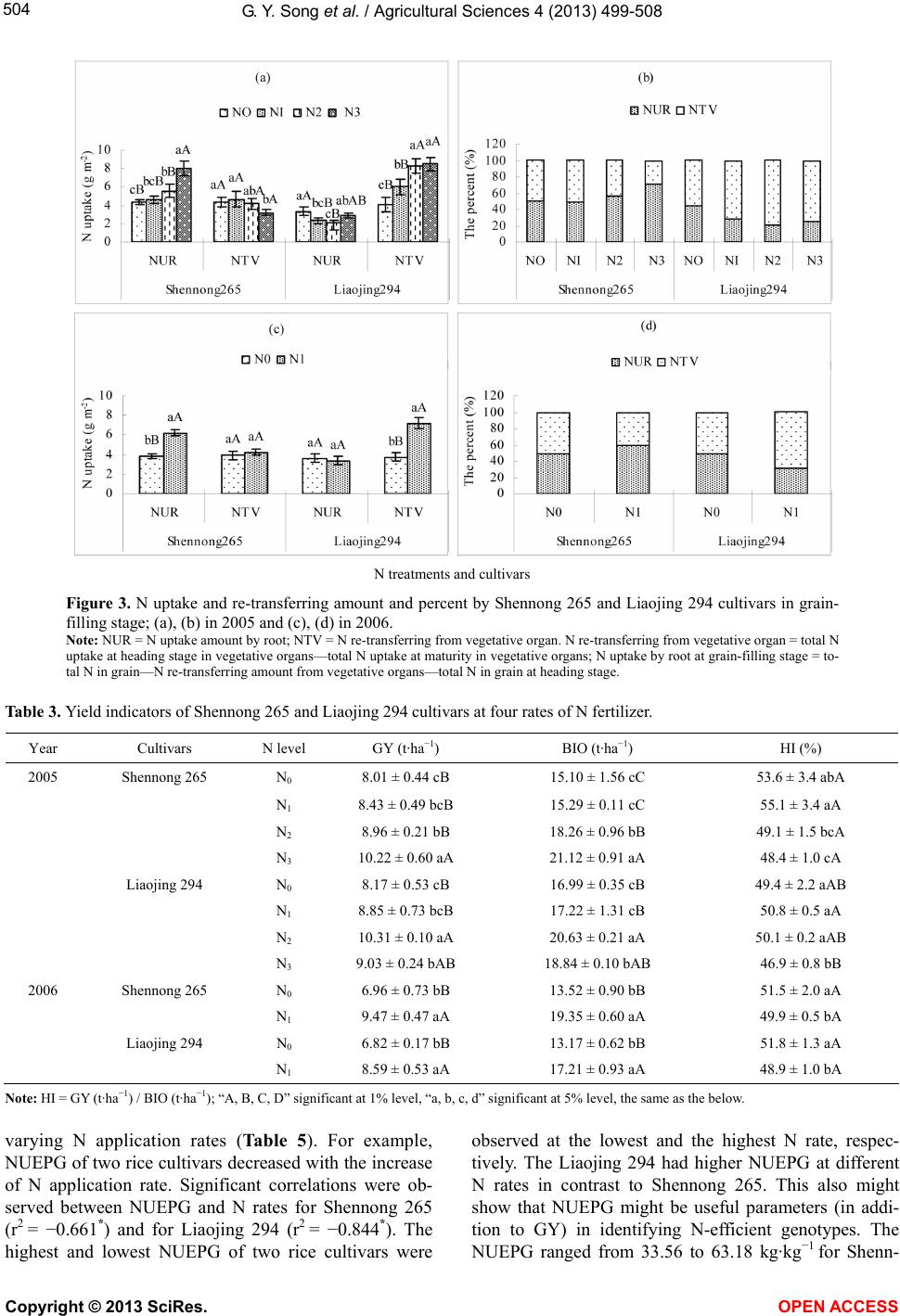 G. Y. Song et al. / Agricultural Sciences 4 (2013) 499-508 504 N treatments and cultivars Figure 3. N uptake and re-transferring amount and percent by Shennong 265 and Liaojing 294 cultivars in grain- filling stage; (a), (b) in 2005 and (c), (d) in 2006. Note: NUR = N uptake amount by root; NTV = N re-transferring from vegetative organ. N re-transferring from vegetative organ = total N uptake at heading stage in vegetative organs—total N uptake at maturity in vegetative organs; N uptake by root at grain-filling stage = to- tal N in grain—N re-transferring amount from vegetative organs—total N in grain at heading stage. Table 3. Yield indicators of Shennong 265 and Liaojing 294 cultivars at four rates of N fertilizer. Year Cultivars N level GY (t·ha−1) BIO (t·ha−1) HI (%) 2005 Shennong 265 N0 8.01 ± 0.44 cB 15.10 ± 1.56 cC 53.6 ± 3.4 abA N 1 8.43 ± 0.49 bcB 15.29 ± 0.11 cC 55.1 ± 3.4 aA N 2 8.96 ± 0.21 bB 18.26 ± 0.96 bB 49.1 ± 1.5 bcA N 3 10.22 ± 0.60 aA 21.12 ± 0.91 aA 48.4 ± 1.0 cA Liaojing 294 N0 8.17 ± 0.53 cB 16.99 ± 0.35 cB 49.4 ± 2.2 aAB N 1 8.85 ± 0.73 bcB 17.22 ± 1.31 cB 50.8 ± 0.5 aA N 2 10.31 ± 0.10 aA 20.63 ± 0.21 aA 50.1 ± 0.2 aAB N 3 9.03 ± 0.24 bAB 18.84 ± 0.10 bAB 46.9 ± 0.8 bB 2006 Shennong 265 N0 6.96 ± 0.73 bB 13.52 ± 0.90 bB 51.5 ± 2.0 aA N 1 9.47 ± 0.47 aA 19.35 ± 0.60 aA 49.9 ± 0.5 bA Liaojing 294 N0 6.82 ± 0.17 bB 13.17 ± 0.62 bB 51.8 ± 1.3 aA N 1 8.59 ± 0.53 aA 17.21 ± 0.93 aA 48.9 ± 1.0 bA Note: HI = GY (t·ha−1) / BIO (t·ha−1); “A, B, C, D” significant at 1% level, “a, b, c, d” significant at 5% level, the same as the below. varying N application rates (Table 5). For example, NUEPG of two rice cultivars decreased with the increase of N application rate. Significant correlations were ob- served between NUEPG and N rates for Shennong 265 (r2 = −0.661*) and for Liaojing 294 (r2 = −0.844*). The highest and lowest NUEPG of two rice cultivars were observed at the lowest and the highest N rate, respec- tively. The Liaojing 294 had higher NUEPG at different N rates in contrast to Shennong 265. This also might show that NUEPG might be useful parameters (in addi- tion to GY) in identifying N-efficient genotypes. The NUEPG ranged from 33.56 to 63.18 kg·kg−1 for Shenn- Copyright © 2013 SciRes. OPEN ACCESS 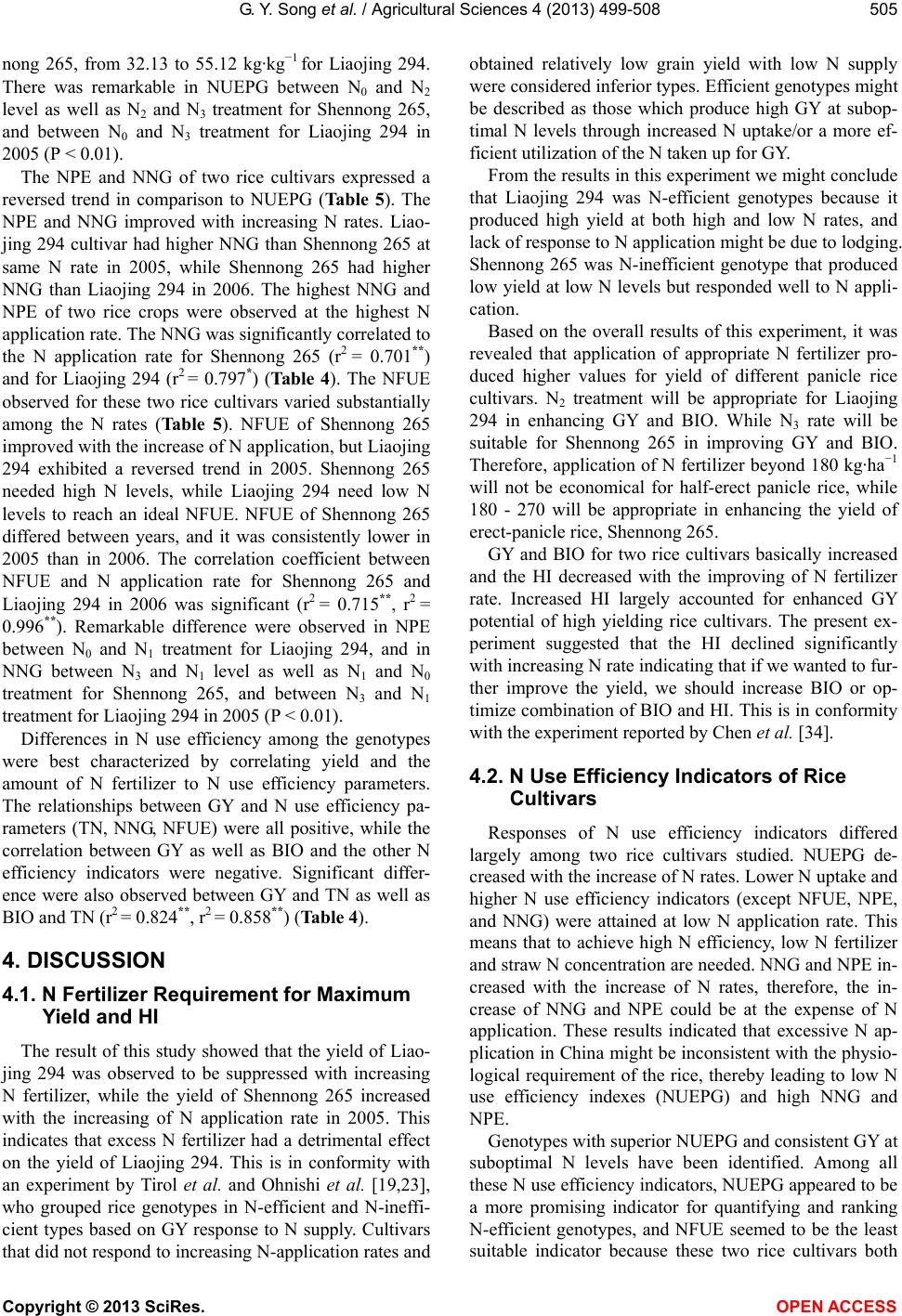 G. Y. Song et al. / Agricultural Sciences 4 (2013) 499-508 505 nong 265, from 32.13 to 55.12 kg·kg−1 for Liaojing 294. There was remarkable in NUEPG between N0 and N2 level as well as N2 and N3 treatment for Shennong 265, and between N0 and N3 treatment for Liaojing 294 in 2005 (P < 0.01). The NPE and NNG of two rice cultivars expressed a reversed trend in comparison to NUEPG (Tab l e 5 ). The NPE and NNG improved with increasing N rates. Liao- jing 294 cultivar had higher NNG than Shennong 265 at same N rate in 2005, while Shennong 265 had higher NNG than Liaojing 294 in 2006. The highest NNG and NPE of two rice crops were observed at the highest N application rate. The NNG was significantly correlated to the N application rate for Shennong 265 (r2 = 0.701**) and for Liaojing 294 (r2 = 0.797*) (Ta b l e 4 ). The NFUE observed for these two rice cultivars varied substantially among the N rates (Table 5). NFUE of Shennong 265 improved with the increase of N application, but Liaojing 294 exhibited a reversed trend in 2005. Shennong 265 needed high N levels, while Liaojing 294 need low N levels to reach an ideal NFUE. NFUE of Shennong 265 differed between years, and it was consistently lower in 2005 than in 2006. The correlation coefficient between NFUE and N application rate for Shennong 265 and Liaojing 294 in 2006 was significant (r2 = 0.715**, r2 = 0.996**). Remarkable difference were observed in NPE between N0 and N1 treatment for Liaojing 294, and in NNG between N3 and N1 level as well as N1 and N0 treatment for Shennong 265, and between N3 and N1 treatment for Liaojing 294 in 2005 (P < 0.01). Differences in N use efficiency among the genotypes were best characterized by correlating yield and the amount of N fertilizer to N use efficiency parameters. The relationships between GY and N use efficiency pa- rameters (TN, NNG, NFUE) were all positive, while the correlation between GY as well as BIO and the other N efficiency indicators were negative. Significant differ- ence were also observed between GY and TN as well as BIO and TN (r2 = 0.824**, r2 = 0.858**) (Table 4). 4. DISCUSSION 4.1. N Fertilizer Requirement for Maximum Yield and HI The result of this study showed that the yield of Liao- jing 294 was observed to be suppressed with increasing N fertilizer, while the yield of Shennong 265 increased with the increasing of N application rate in 2005. This indicates that excess N fertilizer had a detrimental effect on the yield of Liaojing 294. This is in conformity with an experiment by Tirol et al. and Ohnishi et al. [19,23], who grouped rice genotypes in N-efficient and N-ineffi- cient types based on GY response to N supply. Cultivars that did not respond to increasing N-application rates and obtained relatively low grain yield with low N supply were considered inferior types. Efficient genotypes might be described as those which produce high GY at subop- timal N levels through increased N uptake/or a more ef- ficient utilization of the N taken up for GY. From the results in this experiment we might conclude that Liaojing 294 was N-efficient genotypes because it produced high yield at both high and low N rates, and lack of response to N application might be due to lodging. Shennong 265 was N-inefficient genotype that produced low yield at low N levels but responded well to N appli- cation. Based on the overall results of this experiment, it was revealed that application of appropriate N fertilizer pro- duced higher values for yield of different panicle rice cultivars. N2 treatment will be appropriate for Liaojing 294 in enhancing GY and BIO. While N3 rate will be suitable for Shennong 265 in improving GY and BIO. Therefore, application of N fertilizer beyond 180 kg·ha−1 will not be economical for half-erect panicle rice, while 180 - 270 will be appropriate in enhancing the yield of erect-panicle rice, Shennong 265. GY and BIO for two rice cultivars basically increased and the HI decreased with the improving of N fertilizer rate. Increased HI largely accounted for enhanced GY potential of high yielding rice cultivars. The present ex- periment suggested that the HI declined significantly with increasing N rate indicating that if we wanted to fur- ther improve the yield, we should increase BIO or op- timize combination of BIO and HI. This is in conformity with the experiment reported by Chen et al. [34]. 4.2. N Use Efficiency Indicators of Rice Cultivars Responses of N use efficiency indicators differed largely among two rice cultivars studied. NUEPG de- creased with the increase of N rates. Lower N uptake and higher N use efficiency indicators (except NFUE, NPE, and NNG) were attained at low N application rate. This means that to achieve high N efficiency, low N fertilizer and straw N concentration are needed. NNG and NPE in- creased with the increase of N rates, therefore, the in- crease of NNG and NPE could be at the expense of N application. These results indicated that excessive N ap- plication in China might be inconsistent with the physio- logical requirement of the rice, thereby leading to low N use efficiency indexes (NUEPG) and high NNG and NPE. Genotypes with superior NUEPG and consistent GY at suboptimal N levels have been identified. Among all these N use efficiency indicators, NUEPG appeared to be a more promising indicator for quantifying and ranking N-efficient genotypes, and NFUE seemed to be the least suitable indicator because these two rice cultivars both Copyright © 2013 SciRes. OPEN ACCESS 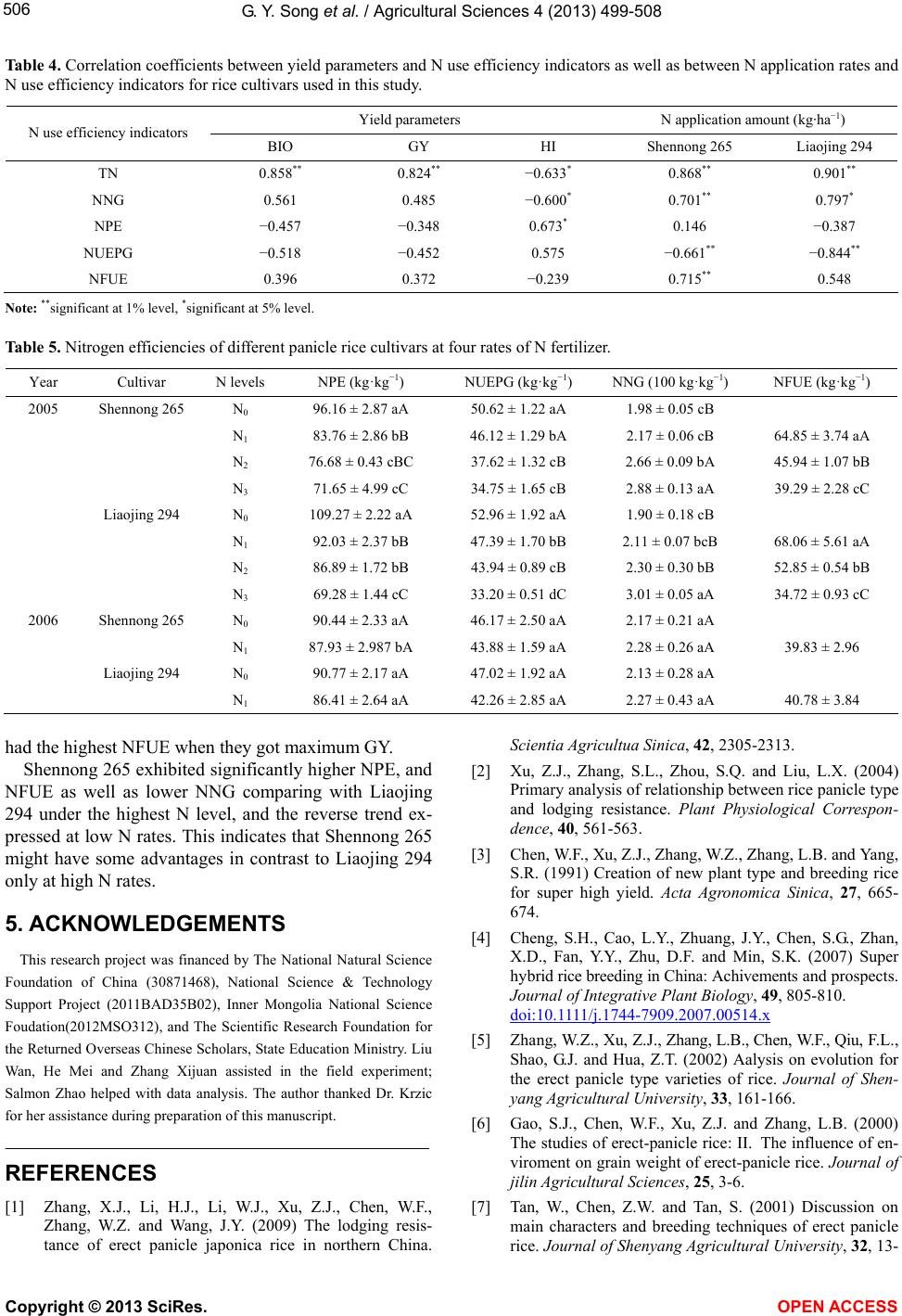 G. Y. Song et al. / Agricultural Sciences 4 (2013) 499-508 Copyright © 2013 SciRes. 506 Table 4. Correlation coefficients between yield parameters and N use efficiency indicators as well as between N application rates and N use efficiency indicators for rice cultivars used in this study. Yield parameters N application amount (kg·ha−1) N use efficiency indicators BIO GY HI Shennong 265 Liaojing 294 TN 0.858** 0.824** −0.633* 0.868** 0.901** NNG 0.561 0.485 −0.600* 0.701** 0.797* NPE −0.457 −0.348 0.673* 0.146 −0.387 NUEPG −0.518 −0.452 0.575 −0.661** −0.844** NFUE 0.396 0.372 −0.239 0.715** 0.548 Note: **significant at 1% level, *significant at 5% level. Table 5. Nitrogen efficiencies of different panicle rice cultivars at four rates of N fertilizer. Year Cultivar N levels NPE (kg·kg−1) NUEPG (kg·kg−1) NNG (100 kg·kg−1) NFUE (kg·kg−1) 2005 Shennong 265 N0 96.16 ± 2.87 aA 50.62 ± 1.22 aA 1.98 ± 0.05 cB N 1 83.76 ± 2.86 bB 46.12 ± 1.29 bA 2.17 ± 0.06 cB 64.85 ± 3.74 aA N 2 76.68 ± 0.43 cBC 37.62 ± 1.32 cB 2.66 ± 0.09 bA 45.94 ± 1.07 bB N 3 71.65 ± 4.99 cC 34.75 ± 1.65 cB 2.88 ± 0.13 aA 39.29 ± 2.28 cC Liaojing 294 N0 109.27 ± 2.22 aA 52.96 ± 1.92 aA 1.90 ± 0.18 cB N 1 92.03 ± 2.37 bB 47.39 ± 1.70 bB 2.11 ± 0.07 bcB 68.06 ± 5.61 aA N 2 86.89 ± 1.72 bB 43.94 ± 0.89 cB 2.30 ± 0.30 bB 52.85 ± 0.54 bB N 3 69.28 ± 1.44 cC 33.20 ± 0.51 dC 3.01 ± 0.05 aA 34.72 ± 0.93 cC 2006 Shennong 265 N0 90.44 ± 2.33 aA 46.17 ± 2.50 aA 2.17 ± 0.21 aA N 1 87.93 ± 2.987 bA 43.88 ± 1.59 aA 2.28 ± 0.26 aA 39.83 ± 2.96 Liaojing 294 N0 90.77 ± 2.17 aA 47.02 ± 1.92 aA 2.13 ± 0.28 aA N 1 86.41 ± 2.64 aA 42.26 ± 2.85 aA 2.27 ± 0.43 aA 40.78 ± 3.84 had the highest NFUE when they got maximum GY. Shennong 265 exhibited significantly higher NPE, and NFUE as well as lower NNG comparing with Liaojing 294 under the highest N level, and the reverse trend ex- pressed at low N rates. This indicates that Shennong 265 might have some advantages in contrast to Liaojing 294 only at high N rates. OPEN ACCESS 5. ACKNOWLEDGEMENTS This research project was financed by The National Natural Science Foundation of China (30871468), National Science & Technology Support Project (2011BAD35B02), Inner Mongolia National Science Foudation(2012MSO312), and The Scientific Research Foundation for the Returned Overseas Chinese Scholars, State Education Ministry. Liu Wan, He Mei and Zhang Xijuan assisted in the field experiment; Salmon Zhao helped with data analysis. The author thanked Dr. Krzic for her assistance during preparation of this manuscript. REFERENCES [1] Zhang, X.J., Li, H.J., Li, W.J., Xu, Z.J., Chen, W.F., Zhang, W.Z. and Wang, J.Y. (2009) The lodging resis- tance of erect panicle japonica rice in northern China. Scientia Agricultua Sinica, 42, 2305-2313. [2] Xu, Z.J., Zhang, S.L., Zhou, S.Q. and Liu, L.X. (2004) Primary analysis of relationship between rice panicle type and lodging resistance. Plant Physiological Correspon- dence, 40, 561-563. [3] Chen, W.F., Xu, Z.J., Zhang, W.Z., Zhang, L.B. and Yang, S.R. (1991) Creation of new plant type and breeding rice for super high yield. Acta Agronomica Sinica, 27, 665- 674. [4] Cheng, S.H., Cao, L.Y., Zhuang, J.Y., Chen, S.G., Zhan, X.D., Fan, Y.Y., Zhu, D.F. and Min, S.K. (2007) Super hybrid rice breeding in China: Achivements and prospects. Journal of Integrative Plant Biology, 49, 805-810. doi:10.1111/ j.1744- 7909.2007.00514.x [5] Zhang, W.Z., Xu, Z.J., Zhang, L.B., Chen, W.F., Qiu, F.L., Shao, G.J. and Hua, Z.T. (2002) Aalysis on evolution for the erect panicle type varieties of rice. Journal of Shen- yang Agricultural University, 33, 161-166. [6] Gao, S.J., Chen, W.F., Xu, Z.J. and Zhang, L.B. (2000) The studies of erect-panicle rice: II. The influence of en- viroment on grain weight of erect-panicle rice. Journal of jilin Agricultural Sciences, 25, 3-6. [7] Tan, W., Chen, Z.W. and Tan, S. (2001) Discussion on main characters and breeding techniques of erect panicle rice. Journal of Shenyang Agricultural University, 32, 13- 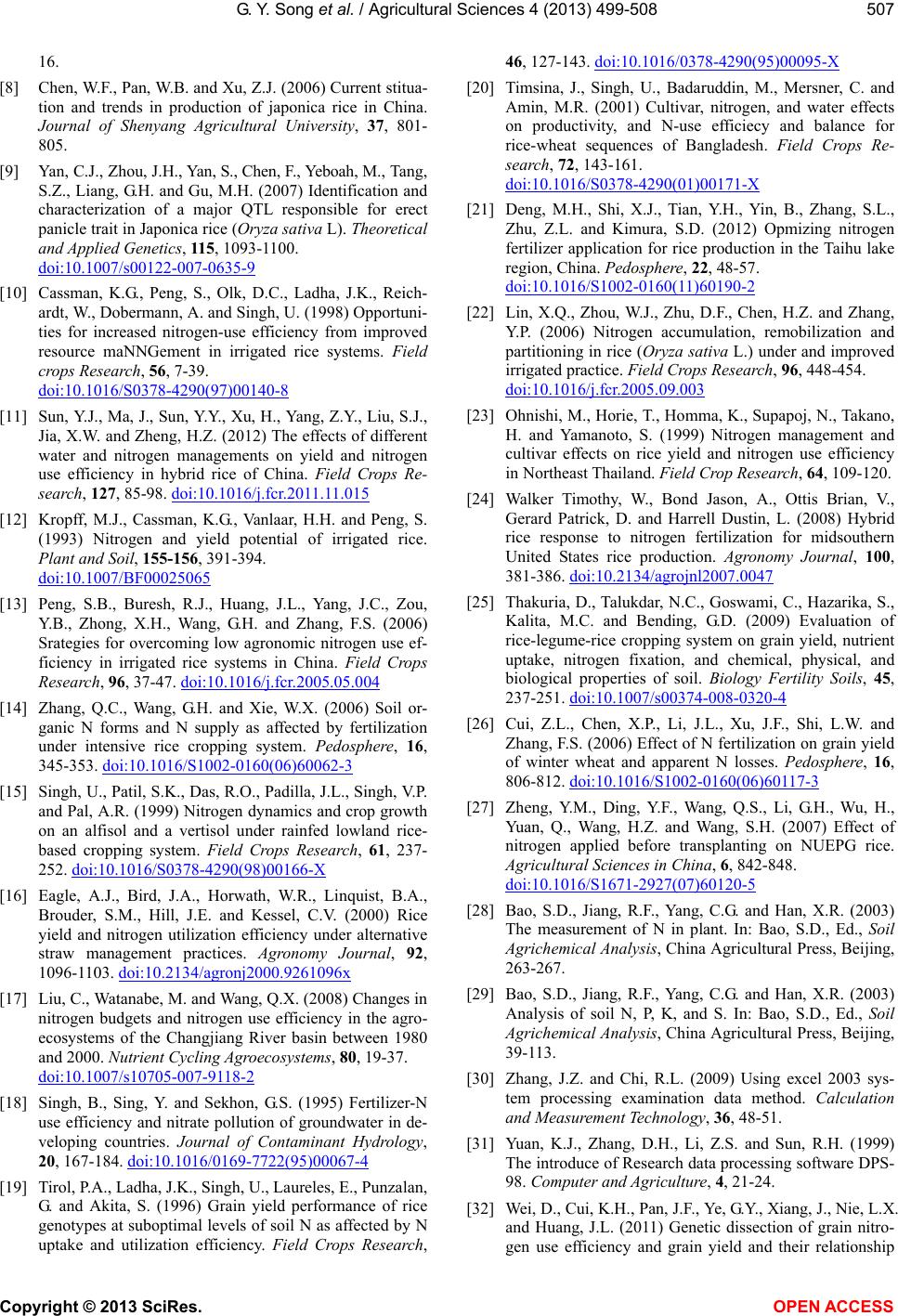 G. Y. Song et al. / Agricultural Sciences 4 (2013) 499-508 507 16. [8] Chen, W.F., Pan, W.B. and Xu, Z.J. (2006) Current stitua- tion and trends in production of japonica rice in China. Journal of Shenyang Agricultural University, 37, 801- 805. [9] Yan, C.J., Zhou, J.H., Yan, S., Chen, F., Yeboah, M., Tang, S.Z., Liang, G.H. and Gu, M.H. (2007) Identification and characterization of a major QTL responsible for erect panicle trait in Japonica rice (Oryza sativa L). Theoretical and Applied Genetics, 115, 1093-1100. doi:10.1007/s00122-007-0635-9 [10] Cassman, K.G., Peng, S., Olk, D.C., Ladha, J.K., Reich- ardt, W., Dobermann, A. and Singh, U. (1998) Opportuni- ties for increased nitrogen-use efficiency from improved resource maNNGement in irrigated rice systems. Field crops Research, 56, 7-39. doi:10.1016/S0378-4290(97)00140-8 [11] Sun, Y.J., Ma, J., Sun, Y.Y., Xu, H., Yang, Z.Y., Liu, S.J., Jia, X.W. and Zheng, H.Z. (2012) The effects of different water and nitrogen managements on yield and nitrogen use efficiency in hybrid rice of China. Field Crops Re- search, 127, 85-98. doi:10.1016/j.fcr.2011.11.015 [12] Kropff, M.J., Cassman, K.G., Vanlaar, H.H. and Peng, S. (1993) Nitrogen and yield potential of irrigated rice. Plant and Soil, 155-156, 391-394. doi:10.1007/BF00025065 [13] Peng, S.B., Buresh, R.J., Huang, J.L., Yang, J.C., Zou, Y.B., Zhong, X.H., Wang, G.H. and Zhang, F.S. (2006) Srategies for overcoming low agronomic nitrogen use ef- ficiency in irrigated rice systems in China. Field Crops Research, 96, 37-47. doi:10.1016/j.fcr.2005.05.004 [14] Zhang, Q.C., Wang, G.H. and Xie, W.X. (2006) Soil or- ganic N forms and N supply as affected by fertilization under intensive rice cropping system. Pedosphere, 16, 345-353. doi:10.1016/S1002-0160(06)60062-3 [15] Singh, U., Patil, S.K., Das, R.O., Padilla, J.L., Singh, V.P. and Pal, A.R. (1999) Nitrogen dynamics and crop growth on an alfisol and a vertisol under rainfed lowland rice- based cropping system. Field Crops Research, 61, 237- 252. doi:10.1016/S0378-4290(98)00166-X [16] Eagle, A.J., Bird, J.A., Horwath, W.R., Linquist, B.A., Brouder, S.M., Hill, J.E. and Kessel, C.V. (2000) Rice yield and nitrogen utilization efficiency under alternative straw management practices. Agronomy Journal, 92, 1096-1103. doi:10.2134/agronj2000.9261096x [17] Liu, C., Watanabe, M. and Wang, Q.X. (2008) Changes in nitrogen budgets and nitrogen use efficiency in the agro- ecosystems of the Changjiang River basin between 1980 and 2000. Nutrient Cycling Agroecosystems, 80, 19-37. doi:10.1007/s10705-007-9118-2 [18] Singh, B., Sing, Y. and Sekhon, G.S. (1995) Fertilizer-N use efficiency and nitrate pollution of groundwater in de- veloping countries. Journal of Contaminant Hydrology, 20, 167-184. doi:10.1016/0169-7722(95)00067-4 [19] Tirol, P.A., Ladha, J.K., Singh, U., Laureles, E., Punzalan, G. and Akita, S. (1996) Grain yield performance of rice genotypes at suboptimal levels of soil N as affected by N uptake and utilization efficiency. Field Crops Research, 46, 127-143. doi:10.1016/0378-4290(95)00095-X [20] Timsina, J., Singh, U., Badaruddin, M., Mersner, C. and Amin, M.R. (2001) Cultivar, nitrogen, and water effects on productivity, and N-use efficiecy and balance for rice-wheat sequences of Bangladesh. Field Crops Re- search, 72, 143-161. doi:10.1016/S0378-4290(01)00171-X [21] Deng, M.H., Shi, X.J., Tian, Y.H., Yin, B., Zhang, S.L., Zhu, Z.L. and Kimura, S.D. (2012) Opmizing nitrogen fertilizer application for rice production in the Taihu lake region, China. Pedosphere, 22, 48-57. doi:10.1016/S1002-0160(11)60190-2 [22] Lin, X.Q., Zhou, W.J., Zhu, D.F., Chen, H.Z. and Zhang, Y.P. (2006) Nitrogen accumulation, remobilization and partitioning in rice (Oryza sativa L.) under and improved irrigated practice. Field Crops Research, 96, 448-454. doi:10.1016/j.fcr.2005.09.003 [23] Ohnishi, M., Horie, T., Homma, K., Supapoj, N., Takano, H. and Yamanoto, S. (1999) Nitrogen management and cultivar effects on rice yield and nitrogen use efficiency in Northeast Thailand. Field Crop Research, 64, 109-120. [24] Walker Timothy, W., Bond Jason, A., Ottis Brian, V., Gerard Patrick, D. and Harrell Dustin, L. (2008) Hybrid rice response to nitrogen fertilization for midsouthern United States rice production. Agronomy Journal, 100, 381-386. doi:10.2134/agrojnl2007.0047 [25] Thakuria, D., Talukdar, N.C., Goswami, C., Hazarika, S., Kalita, M.C. and Bending, G.D. (2009) Evaluation of rice-legume-rice cropping system on grain yield, nutrient uptake, nitrogen fixation, and chemical, physical, and biological properties of soil. Biology Fertility Soils, 45, 237-251. doi:10.1007/s00374-008-0320-4 [26] Cui, Z.L., Chen, X.P., Li, J.L., Xu, J.F., Shi, L.W. and Zhang, F.S. (2006) Effect of N fertilization on grain yield of winter wheat and apparent N losses. Pedosphere, 16, 806-812. doi:10.1016/S1002-0160(06)60117-3 [27] Zheng, Y.M., Ding, Y.F., Wang, Q.S., Li, G.H., Wu, H., Yuan, Q., Wang, H.Z. and Wang, S.H. (2007) Effect of nitrogen applied before transplanting on NUEPG rice. Agricultural Sciences in China, 6, 842-848. doi:10.1016/S1671-2927(07)60120-5 [28] Bao, S.D., Jiang, R.F., Yang, C.G. and Han, X.R. (2003) The measurement of N in plant. In: Bao, S.D., Ed., Soil Agrichemical Analysis, China Agricultural Press, Beijing, 263-267. [29] Bao, S.D., Jiang, R.F., Yang, C.G. and Han, X.R. (2003) Analysis of soil N, P, K, and S. In: Bao, S.D., Ed., Soil Agrichemical Analysis, China Agricultural Press, Beijing, 39-113. [30] Zhang, J.Z. and Chi, R.L. (2009) Using excel 2003 sys- tem processing examination data method. Calculation and Measurement Technology, 36, 48-51. [31] Yuan, K.J., Zhang, D.H., Li, Z.S. and Sun, R.H. (1999) The introduce of Research data processing software DPS- 98. Computer and Agriculture, 4, 21-24. [32] Wei, D., Cui, K.H., Pan, J.F., Ye, G.Y., Xiang, J., Nie, L.X. and Huang, J.L. (2011) Genetic dissection of grain nitro- gen use efficiency and grain yield and their relationship Copyright © 2013 SciRes. OPEN ACCESS  G. Y. Song et al. / Agricultural Sciences 4 (2013) 499-508 Copyright © 2013 SciRes. OPEN ACCESS 508 in rice. Field Crops Research, 124, 340-346. doi:10.1016/j.fcr.2011.07.003 [33] Singh, U., Ladha, J.K., Castillo, E.G., et al. (1998) Geno- typic variation in N use efficiency in medium- and long- duration rice. Field Crops Research, 58, 35-53. doi:10.1016/S0378-4290(98)00084-7 [34] Chen, W.F., Xu, Z.J. and Zhang, L.B. (2003) Physiologi- cal basis of rice breeding for super high yield. In: Zhang, L.B., Ed., The Analysis of Yield Components for Rice Va- rieties in Liaoning Province, Liaoning Science and Tech- nology Publishing House, Shenyang, 24-75.
|